Table of Contents
- Introduction
- Understanding Lead Generation
- The Importance of Lead Generation
- The Lead Generation Process
- Strategies for Online Lead Generation
- 5.1 Content Creation and Promotion
- 5.2 Email Marketing
- 5.3 Social Media Marketing
- 5.4 Search Engine Optimization (SEO)
- 5.5 Pay-Per-Click Advertising (PPC)
- 5.6 Webinars and Online Events
- 5.7 Landing Pages and Lead Magnets
- 5.8 Referral Programs
- Effective Lead Qualification
- Lead Scoring and Management
- The Benefits of Inbound Lead Generation
- Offline Lead Generation Tactics
- 9.1 Networking and Events
- 9.2 Print Advertising
- 9.3 Direct Mail Campaigns
- 9.4 Public Relations and Media Outreach
- Tools and Technologies for Lead Generation
- Measuring and Analyzing Lead Generation Efforts
- Conclusion

1. Introduction
In today’s competitive business landscape, generating a consistent stream of leads is essential for sustainable growth and success. One of the most effective ways to achieve this is through online lead generation. By leveraging various digital marketing strategies and techniques, businesses can attract potential clients and convert them into valuable leads. This comprehensive guide will explore the ins and outs of online lead generation, providing valuable insights and actionable tips to help you boost your client base.

100% FREE REPORT!
"Get Instant Access To My Top 10 Coaching Resources To Kick-Start Your Coaching Business"
Simply enter your email below so we know where to send it...
2. Understanding Lead Generation
Lead generation is the process of capturing the contact information of potential customers who have shown interest in a company’s products or services. Unlike traditional outbound marketing approaches, such as cold calling, online lead generation focuses on attracting and engaging prospects through valuable content, targeted advertising, and personalized communication. By nurturing these leads and building relationships with them, businesses can increase their chances of converting them into paying customers.
3. The Importance of Lead Generation
Effective lead generation is crucial for several reasons. First and foremost, it helps businesses expand their client base and increase sales revenue. By consistently generating a flow of qualified leads, companies can ensure a steady stream of potential customers to engage with and convert. Moreover, lead generation allows businesses to target their marketing efforts more efficiently, saving time and resources by focusing on individuals who have already expressed interest in their offerings.
4. The Lead Generation Process
The lead generation process consists of several key steps, starting with attracting potential leads and ending with converting them into customers. Here’s a breakdown of the typical lead generation process:
- Attraction: Businesses employ various marketing tactics to attract potential leads, such as creating compelling content, running targeted advertising campaigns, and optimizing their online presence for search engines.
- Engagement: Once potential leads have been attracted, businesses engage with them through personalized communication, offering valuable resources, answering their queries, and building trust.
- Capture: During the engagement phase, businesses capture the contact information of potential leads, usually through forms on landing pages or lead magnets like ebooks, whitepapers, or webinars.
- Nurture: After capturing the lead’s information, businesses nurture them through targeted email campaigns, social media engagement, and personalized content to keep them engaged and move them further down the sales funnel.
- Conversion: The ultimate goal of lead generation is to convert leads into paying customers. This is achieved through effective sales strategies, personalized offers, and timely follow-ups.

5. Strategies for Online Lead Generation
To maximize the effectiveness of online lead generation, businesses can employ a range of strategies. Let’s explore some of the most effective approaches:
5.1 Content Creation and Promotion
Creating high-quality, informative content is a powerful way to attract potential leads and establish thought leadership in your industry. By publishing blog posts, articles, videos, and other forms of content, businesses can provide value to their target audience and position themselves as trusted authorities. Promoting this content through social media, email marketing, and search engine optimization (SEO) can help drive traffic to your website and generate leads.
5.2 Email Marketing
Email marketing remains one of the most effective lead generation tactics. Building an email list allows businesses to nurture leads by sending targeted, personalized messages that cater to their specific needs and interests. By providing valuable content, exclusive offers, and relevant updates, businesses can keep leads engaged and increase their chances of conversion.
5.3 Social Media Marketing
Social media platforms offer a vast audience for lead generation. By creating engaging and shareable content, participating in industry discussions, and building relationships with potential leads, businesses can attract and capture valuable leads. Social media advertising also provides targeted options to reach specific demographics and interests, further enhancing lead generation efforts.
5.4 Search Engine Optimization (SEO)
Optimizing your website and content for search engines is essential for driving organic traffic and generating leads. By conducting keyword research, optimizing on-page elements, creating valuable backlinks, and improving site speed, businesses can improve their search engine rankings and attract potential leads who are actively searching for their products or services.
5.5 Pay-Per-Click Advertising (PPC)
PPC advertising allows businesses to reach a highly targeted audience and generate leads quickly. By bidding on relevant keywords, creating compelling ad copy, and optimizing landing pages, businesses can drive traffic to their website and capture leads through forms or lead magnets. Platforms like Google Ads and social media advertising offer robust targeting options to maximize lead generation efforts.
5.6 Webinars and Online Events
Hosting webinars and online events is an effective way to engage potential leads and establish authority in your industry. By offering valuable insights, expert advice, and interactive sessions, businesses can attract a highly engaged audience and capture leads through registration forms. Webinars also provide an opportunity to showcase products or services, answer questions, and nurture leads throughout the sales process.
5.7 Landing Pages and Lead Magnets
Creating dedicated landing pages with compelling offers, such as ebooks, guides, or free consultations, is a proven method for lead generation. By providing valuable resources in exchange for contact information, businesses can capture leads and begin nurturing them through targeted email campaigns and personalized communication.
5.8 Referral Programs
Referral programs encourage satisfied customers to refer their friends, family, or colleagues to your business. By incentivizing referrals through discounts, rewards, or exclusive offers, businesses can tap into their existing customer base and generate high-quality leads. Referral programs are highly effective because leads who come through referrals are often pre-qualified and more likely to convert.
6. Effective Lead Qualification
Lead qualification is a crucial step in the lead generation process. Not all leads are created equal, and businesses need to focus their efforts on leads that are most likely to convert into customers. Effective lead qualification involves assessing a lead’s fit with your target audience, their level of interest and engagement, and their readiness to make a purchase. By implementing lead scoring, demographic analysis, and behavioral tracking, businesses can prioritize their efforts on leads that have the highest potential for conversion.
7. Lead Scoring and Management
Lead scoring is a method of ranking and prioritizing leads based on their level of engagement, interest, and fit with your ideal customer profile. By assigning scores to various actions and behaviors, businesses can identify the most qualified leads and focus their efforts on nurturing and converting them. Implementing a robust lead management system, such as a customer relationship management (CRM) platform, allows businesses to track and analyze lead interactions, automate lead nurturing workflows, and optimize their lead generation efforts.

8. The Benefits of Inbound Lead Generation
Inbound lead generation, which focuses on attracting potential customers through valuable content and personalized communication, offers several advantages over traditional outbound marketing approaches. By adopting an inbound lead generation strategy, businesses can:
- Build trust and establish thought leadership in their industry
- Target and attract highly qualified leads who are actively seeking information or solutions
- Nurture leads through personalized communication and valuable resources
- Optimize lead conversion rates by focusing on engaged and interested prospects
- Improve customer retention and loyalty through ongoing engagement and relationship-building efforts
9. Offline Lead Generation Tactics
While online lead generation strategies are highly effective, businesses should not overlook the power of offline tactics. Some proven offline lead generation tactics include:
9.1 Networking and Events
Attending industry conferences, trade shows, and networking events allows businesses to connect with potential leads face-to-face. By engaging in meaningful conversations, exchanging contact information, and following up promptly, businesses can generate valuable leads and build long-lasting relationships.
9.2 Print Advertising
Print advertising, such as newspaper ads, magazine features, and direct mail campaigns, can still be effective for lead generation. By targeting specific publications or local markets, businesses can reach a relevant audience and capture leads through compelling offers or call-to-action promotions.
9.3 Direct Mail Campaigns
Direct mail campaigns involve sending physical mail, such as postcards, brochures, or catalogs, to potential leads. By combining creative design, personalized messaging, and targeted mailing lists, businesses can attract attention, generate interest, and capture leads through response mechanisms like QR codes or landing page URLs.
9.4 Public Relations and Media Outreach
Public relations efforts, such as press releases, media appearances, and industry collaborations, can generate valuable exposure and attract potential leads. By positioning your business as an expert in your field and leveraging media channels, businesses can reach a wider audience and generate leads through earned media coverage.
10. Tools and Technologies for Lead Generation
Numerous tools and technologies are available to streamline and enhance the lead generation process. Some essential tools include:
- CRM platforms: Customer relationship management software helps businesses manage and track leads, automate workflows, and optimize lead nurturing efforts.
- Marketing automation tools: These tools enable businesses to automate repetitive marketing tasks, segment leads, and deliver personalized content and offers.
- Landing page builders: Platforms that allow businesses to create and optimize landing pages quickly and easily, capturing leads and driving conversions.
- Analytics and tracking tools: By tracking website and campaign performance, businesses can gain valuable insights into lead generation efforts and make data-driven decisions to optimize their strategies.
11. Measuring and Analyzing Lead Generation Efforts
Measuring and analyzing lead generation efforts is essential for optimizing performance and identifying areas for improvement. By tracking key metrics, such as conversion rates, cost per lead, and lead-to-customer conversion rates, businesses can assess the effectiveness of their strategies and make data-driven decisions to optimize their lead generation efforts. Implementing robust analytics tools, conducting A/B testing, and regularly reviewing performance metrics can help businesses refine their lead generation strategies and achieve better results.
12. Conclusion
Online lead generation is a vital component of a successful marketing strategy. By implementing effective lead generation tactics, businesses can attract, capture, and nurture valuable leads, ultimately converting them into loyal customers. Whether through content creation, email marketing, social media engagement, or offline tactics, businesses can leverage a range of strategies to generate a consistent flow of qualified leads. By focusing on lead qualification, lead scoring, and effective lead management, businesses can optimize their lead generation efforts and drive long-term growth and success.
